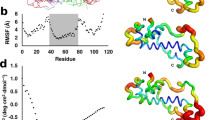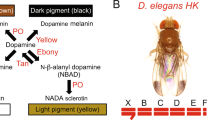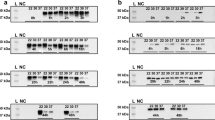Abstract
ELECTROPHORETIC surveys of Drosophila species1 show that many gene–enzyme systems are essentially monomorphic. Very often, however, one or more populations may contain rare alleles, that is, at frequencies less than 5%. Are these alleles selectively neutral and rare because of historical accidents2 or are they deleterious and maintained in populations only through mutation? The dimeric enzyme α-glycerophosphate dehydrogenase (αGPDH) is a good example of an essentially monomorphic Drosophila gene–enzyme system. Out of the 101 species of Drosophila surveyed thus far for electrophoretic variation of αGPDH (refs 3–5), only D. melanogaster is polymorphic. This polymorphism seems to be maintained by selection with temperature being, or strongly correlated with, the selective agent6–8. Microcomplement fixation experiments indicate that this enzyme is evolving slowly among Drosophila species and has accepted relatively few changes in its structure9. We propose that the rare alleles of the αGPDH locus found in some species (see ref. 5) may be at low frequencies because the products of these alleles (allozymes) are catalytically less efficient than their ‘wild-type’ counterparts.
This is a preview of subscription content, access via your institution
Access options
Subscribe to this journal
Receive 51 print issues and online access
$199.00 per year
only $3.90 per issue
Buy this article
- Purchase on SpringerLink
- Instant access to full article PDF
Prices may be subject to local taxes which are calculated during checkout
Similar content being viewed by others
References
Powell, J. F., Evol. Biol. 8, 79–199 (1975).
Robertson, A., Genetics 81, 775–785 (1975).
Zouros, E., Nature 254, 446–448 (1975).
Barker, J. S. F. & Mulley, J. C., Evolution 30, 213–233 (1976).
Collier, G. E., Isozyme Bull. 10, (in the press).
Berger, E., Genetics 67, 121–136 (1971).
Johnson, F. M. & Schaffer, H. E., Biochem. Genet. 10, 149–163 (1973).
Miller, S., Pearcy, R. W. & Berger, E., Biochem. Genet. 13, 175–188 (1975).
Collier, G. E. & MacIntyre, R. J., Proc. natn. Acad. Sci. U.S.A. 77, 684–688 (1977).
Collier, G. E. thesis, Cornell Univ. (1976).
Stamatoyannopoulos, G., A. Rev. Genet. 6, 47–70 (1972).
Berger, E., Am. Nat. 110, 823–839 (1976).
Collier, G. E., Sullivan, D. T. & MacIntyre, R. J., Biochim. biophys. Acta 429, 316–323 (1976).
Chovnick, A., Gelbart, W., McCarron, M., Osmond, B., Candido, E. P. M. & Baillie, D. L., Genetics 84, 233–255 (1976).
Author information
Authors and Affiliations
Rights and permissions
About this article
Cite this article
COLLIER, G., MACINTYRE, R. Low specific activity of rare allozymes of α-glycerophosphate dehydrogenase in Drosophila. Nature 267, 839–841 (1977). https://doi.org/10.1038/267839a0
Received:
Accepted:
Published:
Issue date:
DOI: https://doi.org/10.1038/267839a0
This article is cited by
-
Allozyme polymorphism of Mdh and α-Gpdh in Ixodes ricinus populations: comparison of borreliae-infected and uninfected ticks
Experimental and Applied Acarology (2006)
-
Low activity sn-glycerol-3-phosphate dehydrogenase variants in natural populations of Drosophila melanogaster
Heredity (1991)
-
Extensive variation at the ?-glycerophosphate dehydrogenase locus in species of waterstriders (Gerridae: Hemiptera)
Biochemical Genetics (1981)
-
Analysis of ?-glycerophosphate dehydrogenase variability in the tick ixodes ricinus (Acari: Ixodidae)
Genetica (1979)



